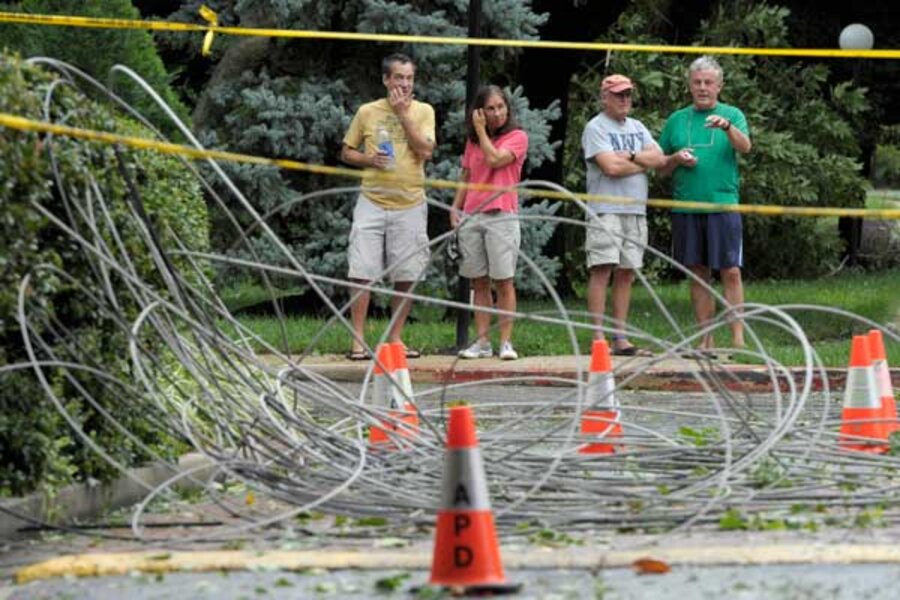Irene leaves 5.5 million without power. Can power companies do better?
Loading...
| Boston
With more than 5 million people without power Monday, hurricane Irene's impact is one of the widest ever, leaving infrastructure experts pondering how to do a better job helping power companies to anticipate outages and restore power more quickly.
As of Monday morning, a total of 5.5 million customers were without power, down from about 5.9 million Sunday, according to data from the US Department of Energy. Downed trees fell on power lines across more than a dozen states, and PJM Interconnect, one of the nation's largest electrical-system operators, has said fully restoring power in its region alone is expected to be a "lengthy" process due to the breadth of the outages.
Power companies are seeking ways to improve their performance. New digital forecasting systems tested on Irene promise to predict more accurately where and how much damage hurricane winds are likely to cause. Alternately, burying wires would keep them safe from storms.
But it is a problem that defies a simple solution, experts say. Utilities had good advance warning with Irene, spending nearly a week organizing response crews and borrowing equipment and personnel from as far away as Texas, according to the Electric Power Research Institute (EPRI), a nonprofit group. But there's only so much that can be done to respond to a storm of such size, some say.
"In a big event like this, there's all the damage the storm does, but afterward it's also a logistical nightmare getting enough people to get things fixed," says Tom Short, EPRI's researcher on distribution system reliability.
Data showed the breadth of storm's impact on utilities.
- By region, at least 1.7 million people were without power across the six New England states, nearly 1 million in New York, and 2 million more in Pennsylvania, Maryland, New Jersey, and other mid-Atlantic states, according to regional power grid operators, distribution utilities, and government officials.
- By state, Connecticut had the largest number of customers without power (693,000) as well as the highest percentage (44), the Department of Energy reported. Maryland had 506,000 customers without power (about 22 percent), and Massachusetts had 567,000 customers without power (about 19 percent).
New forecasting systems are seen as one key way to drive down such numbers in the future. The models would help utilities order sufficient numbers of repair crews in anticipation of storm damage, scientists say. Because it can cost millions to bring in crews from out of state, the issue is vital for utilities.
Using utility data on where outages occurred, scientists at Johns Hopkins University in Baltimore developed forecast models. The models take into account myriad elements that could cause poles or trees to topple on power lines, including wind speeds, soil moisture, topography, and land use.
Calculations before Irene hit suggested that utilities in the Maryland region were likely to need far more personnel than they initially planned, says Seth Guikema, assistant professor of environmental engineering at Johns Hopkins.
One utility, he said, announced before Irene arrived that it had a couple hundred crews to handle an expected 100,000 outages. But thousands of crews were eventually needed to handle about 630,000 outages.
"Our model was forecasting about 500,000 outages just for Maryland," Mr. Guikema says. "If they had worked from that, they would have been better prepared. We think we have something utilities will be able to use going forward."
Others suggest utilities should move toward putting more power lines underground. More than 3 million miles of electrical cables are strung overhead across the country, according to a study by Underground2020.org, a group organized to lobby for more underground utility lines.
"The cost is higher to put them underground, but that's a short-term view," says Don Buckner, who heads the group. "The utilities could easily justify putting them underground if they calculate the entire cost – including people losing heat, losing their refrigeration.... But the utilities companies don't want to spend the money to put them underground. That's the challenge."
About half of all capital spending on power lines by US investor-owned utilities has been for underground wires, Mr. Buckner's group reports. Currently, about 70 percent of the wires that take electricity the last few miles to homes and businesses have been built overhead.
But the cost can be steep, the industry says. A 2005 study in Virginia put conversion costs at $800,000 per mile – about $41 billion overall.
"Virtually all objective observers in recent years have termed the effort prohibitively expensive," utility Dominion Resources reports on its website – an assertion Buckner disputes.
Current estimates put the total costs of hurricane Irene – beyond utility costs alone – as high as $10 billion.





